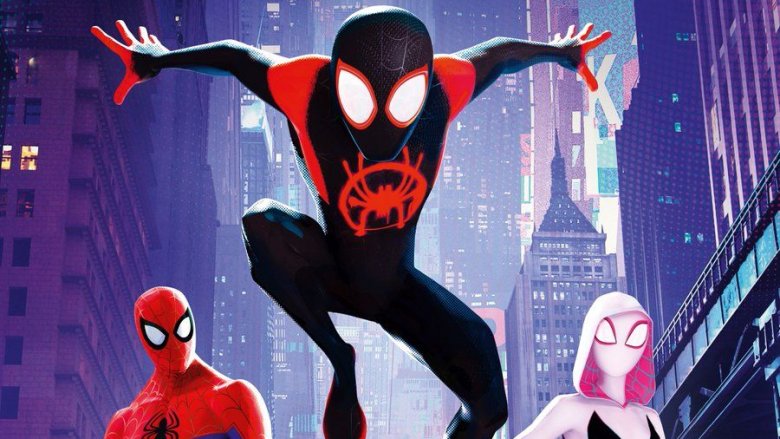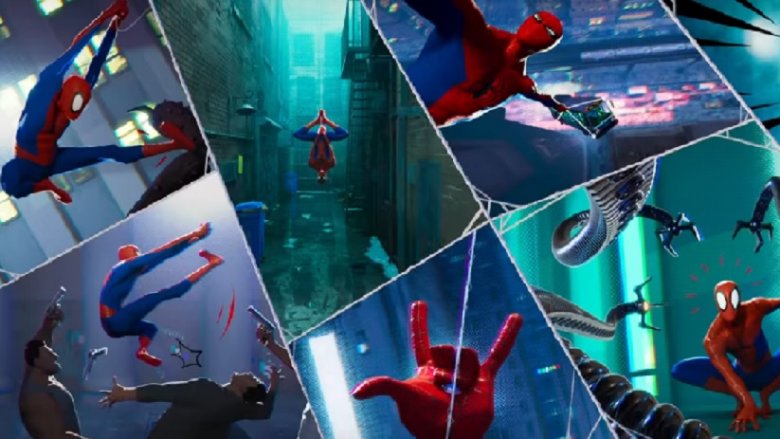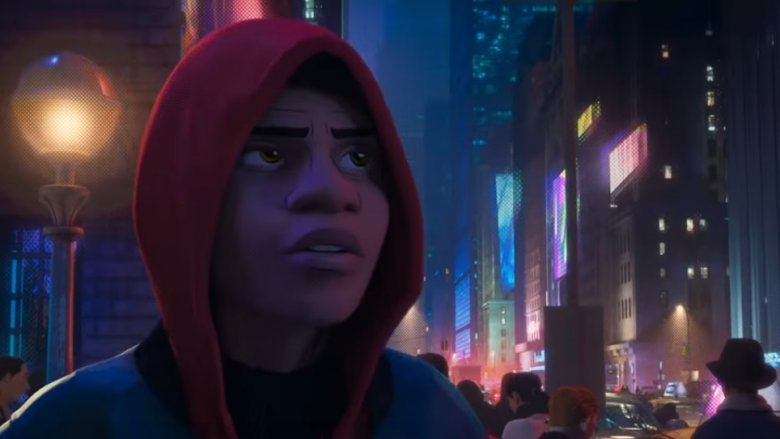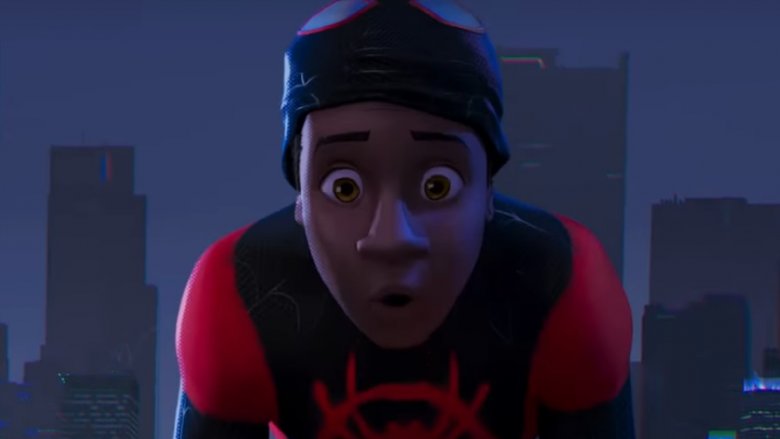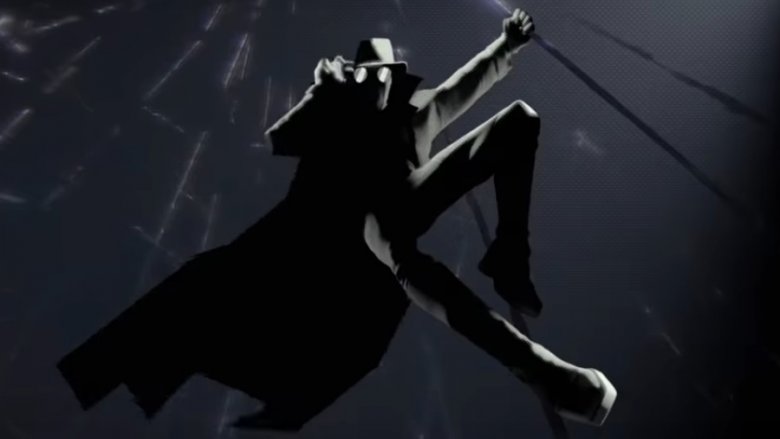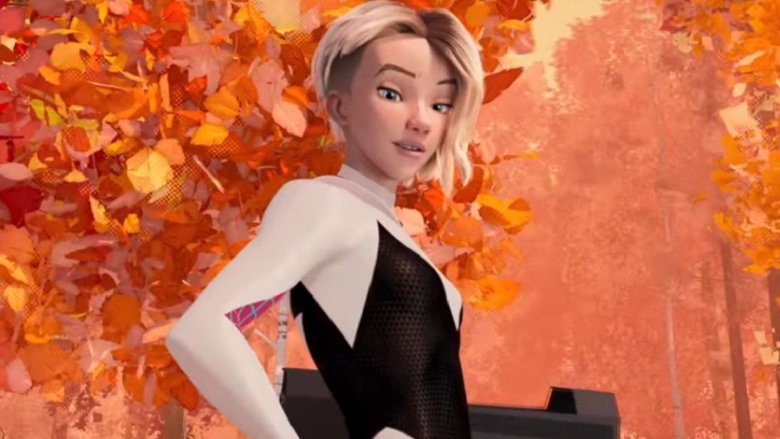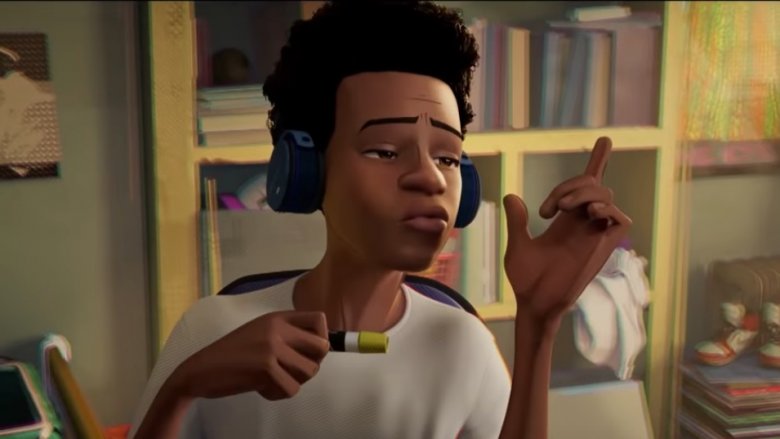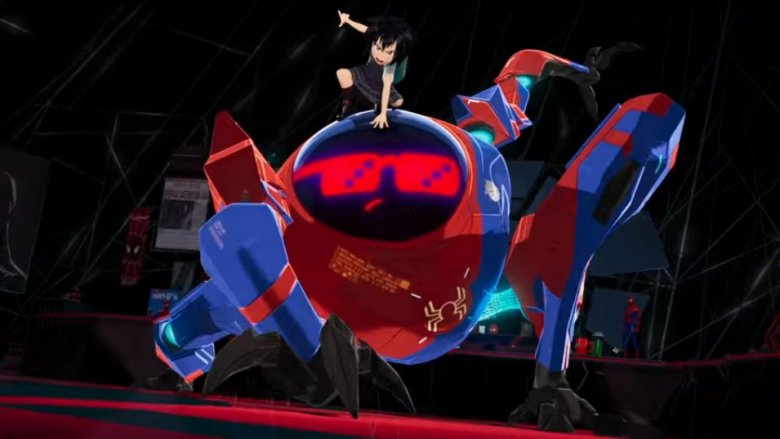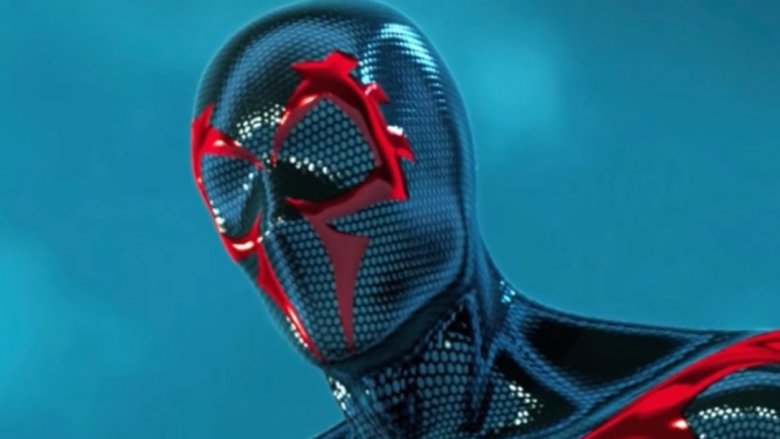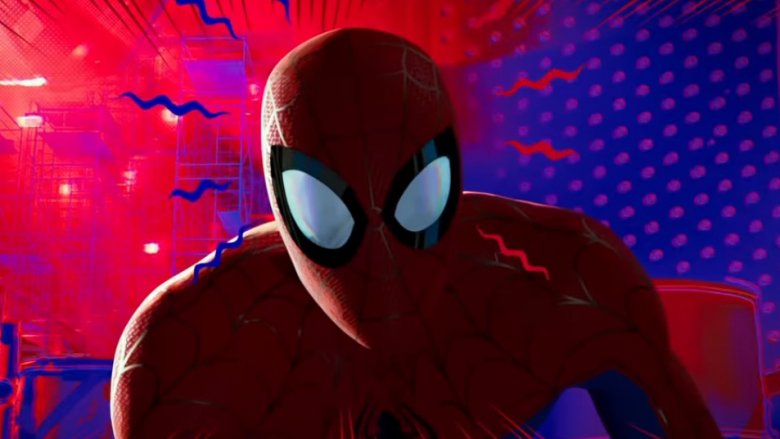5 Best And 5 Worst Things About Spider-Man: Into The Spider-Verse
Sony Pictures Animation's Spider-Man: Into the Spider-Verse is finally here, and it is — in a word — amazing. When Sony first announced their intention to develop a slate of Spidey-related films in the wake of their shared custody arrangement with Marvel Studios, some observers were understandably skeptical about whether or not there would be an audience for such projects (or, indeed, if any of them would even happen). But said observers were silenced by the blockbuster success of Sony's Venom, which succeeded largely on the strength of star Tom Hardy's, shall we say, committed performance. With Into the Spider-Verse, Sony is proving that they actually have a vision for their non-MCU Spidey fare — and it's a surprisingly vital one.
The flick is quite unlike any Spider-Man film or animated superhero feature yet produced. It's a hilarious, at times poignant, action-packed story influenced directly by a 2014 Marvel Comics storyline in which multiple alternate universe versions of Spider-Man must come together to stop a looming threat. It's also rendered in a startlingly unique fashion and brought to life by top-shelf voice talent. Because of its immense buzz and rapturous critical reception, a sequel has already been greenlit, which is a very good thing — but no film is perfect. With a few tweaks, the next entry in the Spider-Verse saga could be even better. Here are some aspects of Spider-Man: Into the Spider-Verse which the filmmakers totally nailed, and some which left a little room for improvement.
Minor spoilers abound.
Best: The animation
First things first: the film's animation is absolutely spectacular, except for one key element (more on that in a moment). It looks as if it were ripped from the pages of a comic book, in more ways than one. Not only is the character design pretty much perfect, but the film makes frequent (and clever) use of comic book tropes such as dialogue boxes revealing the characters' inner thoughts and sound effects which are spelled out onscreen. At times, the animation straddles a fine line between the styles of comic books and cartoons — which is altogether appropriate for a PG-rated film featuring the first onscreen appearance of Spider-Ham (John Mulaney), an alternate version of Spidey who is a talking, anthropomorphic pig (and who at one point asks a bad guy if he has a problem with cartoons).
Into the Spider-Verse takes full advantage of its medium, with knockout action sequences that would have been difficult (if not impossible) to create in live action, and characters that simply would not have worked otherwise, like Spider-Ham and Peni Parker (an anime-influenced female version of Peter who has a telepathic link with a hulking robot called SP//dr). But for all that Into the Spider-Verse gets right in this respect, there's one aesthetic choice that could have perhaps been reined in a little bit.
Worst: The rendering of the backgrounds
The filmmakers took the comics-inspired look of the film to an extreme never before seen on film, and when it works, it really works... but when it doesn't, it becomes a distracting eyesore, and this is most apparent when paying attention to the rendering of the film's backgrounds. It's obvious that a concerted attempt was made to replicate the sometimes-imperfect look of the printed page, complete with dots, printing artifacts, and distant objects which at times appear blurry. It's a bit of a strange contrast with the clean, sharp lines of the characters and foregrounds, and at times, it doesn't so much invoke comic book art as it does threaten to give the viewer a headache.
At its worst, the rendering produces a weird doubling effect in the backgrounds that might leave some viewers wondering if they accidentally wandered into a 3-D screening without glasses. Fans who have spent plenty of time with their noses in comic books will no doubt recognize immediately what the filmmakers were going for, but that doesn't make the choice any less distracting. For those who are less familiar with the quirks of comic book art on the printed page, it might very well just come off as sloppy.
Best: The lead character
Into the Spider-Verse gives Spidey fans something that many of them have long been clamoring for: the first big-screen appearance of Miles Morales, the Afro-Latino teen who took over as Spider-Man in the now-defunct Ultimate universe before plot machinations transplanted him to the mainstream Marvel continuity. Many observers were of the opinion that Miles should have been the MCU's Spidey, but this would have made little sense — without giving away too much, an incident involving Miles and Peter Parker (portrayed reasonably faithfully in Into the Spider-Verse) is just as key to Miles' character as Peter's relationship with Uncle Ben is to his. But good things come to those who wait, and Into the Spider-Verse's depiction of Miles is excellent.
The film's characterization significantly tones down Miles' initial reluctance to take on the Spider-Man mantle, but this just serves to streamline the narrative. The voice performance by Shameik Moore (Dope) is spot-on, expertly capturing Miles' awkwardness, humor, and determination. He makes every step of the teen's arc from vulnerable kid to badass hero ring true, and he has an excellent chemistry with a pudgy, schlubby alternate-universe Peter Parker (New Girl's Jake Johnson). But unfortunately, that chemistry also serves to highlight one of the flick's other shortcomings.
Worst: Some characters get short shrift
Into the Spider-Verse employs a hilarious device to introduce all of its alternate Spideys. At the film's beginning, Peter Parker briefly explains his origin and career as Spider-Man in a voiceover which is echoed (after some variation of "okay, let's try this again") by each of the successive alternates as they're introduced. This device is so light-hearted and funny that it's easy to ignore how it effectively glosses over the origins and careers of these other characters — but it does, and this is a little unfortunate.
For instance, we don't get any kind of a feel for the home universes of Peni Parker and Spider-Ham (which could have been mined for humor, if nothing else), and similar short shrift is given to the intriguing character of Spider-Man Noir (Nicolas Cage), a version of Peter from the 1930's. While these characters are briefly given time to shine in action sequences (and a running gag involving the black-and-white Spidey Noir struggling to comprehend a Rubik's cube is nothing short of inspired), the brief, montage-style introductions have the effect of leaving all of the alternate Spideys feeling a bit underdeveloped. All of them, that is, except one.
Best: Spider-Gwen
Introduced at the outset of the comics' Spider-Verse event, Spider-Gwen (referred to in-universe as Spider-Woman) is an alternate version of Gwen Stacy who was bitten by the radioactive spider instead of her friend Peter, whom she failed to save from an untimely death (giving her the same guilt-tinged motivation that all Spider-People must have). The character has become a massive hit with fans, having starred in her own comic series since 2015. Her appearance in Into the Spider-Verse was highly anticipated, and did not disappoint.
Voiced by Hailee Steinfeld of the Pitch Perfect series, Into the Spider-Verse's Gwen is everything fans could have hoped for — highly capable, compassionate-yet-sarcastic, and usually the smartest person in the room. Her initial meeting with Miles is nothing short of hysterical (she sports that haircut for a reason), and her action sequences pack a satisfying punch. Fans will recall that at the conclusion of the Spider-Verse comic event, Gwen was left with a device which enabled her to travel throughout the multiverse — and, without giving away too much, Into the Spider-Verse contains a firm nod to this. The character and Steinfeld's performance are appealing enough that it's no wonder Sony has greenlit an all-female Into the Spider-Verse spin-off, in which Gwen will almost certainly take the lead.
Worst: The Kingpin
Into the Spider-Verse features more than one villain, but discussing them all would venture a bit too far into spoiler territory. The film's Big Bad is Wilson Fisk, a.k.a. the Kingpin — and while it's a perfectly acceptable choice, some fans might find that Fisk's characterization leaves a bit to be desired. He's voiced by Liev Schrieber, a fine actor who nevertheless turns in something of a flat performance. It could also be argued that Fisk (who has no superhuman abilities in the comics) is a bit overpowered in this film, illustrated by one key moment which we won't get into here. The character's rendering is also a bit distracting, as he is roughly the size of a van (and shaped like one, as well), easily four or five times larger than any other human character in the film.
All of this would have been a little easier to overlook if not for the fact that the definitive live action version of Fisk, as portrayed by the great Vincent D'Onofrio in the Netflix Marvel series Daredevil, is still fresh in the minds of many fans (and is light-years more complex than the version Into the Spider-Verse gives us). The filmmakers apparently took little to no inspiration from D'Onofrio's portrayal, to the extent that it almost feels like they were consciously trying to avoid the comparison. Understandable though this may be, every superhero film needs a great villain, and Schrieber's Kingpin is merely pretty good.
Best: The soundtrack
Into the Spider-Verse's soundtrack earns points for being fresh, contemporary, and altogether appropriate for an urban teen hero. A short scene of Miles attempting (and largely failing) to rap along to a Post Malone song is a highlight, and tracks from Outasight, Vince Staples, Blackway and Black Caviar, and Nicki Minaj also make appearances. It seems like a playlist curated by Miles himself, which was almost certainly the idea. One early sequence takes the soundtrack's hip-hop aesthetic even further, as Miles is induced to take part in a time-honored New York tradition by his wayward uncle Aaron Davis.
Davis convinces his young nephew (who is something of an artist) to accompany him on a nighttime run tagging up subway cars, and it's during this scene that the soundtrack takes a sudden leap back in time. We hear a medley of classic hip-hop tunes from the likes of Black Sheep, Run-DMC, and the Jimmy Castor Bunch (whose song "It's Just Begun" is a formative hip-hop document). A rapidly-cut sequence as Miles navigates his school day also makes brilliant use of Blackalicious' "Chemical Calisthenics," a deep cut from their 2002 release Blazing Arrow. It's obvious that a great deal of thought went into the tunes selected for the soundtrack, and the film is all the better for it.
Worst: A key "death"
Be warned that we'll be discussing a relatively major spoiler here. The character of Peni Parker (Kimiko Glenn, Orange is the New Black) as seen in Into the Spider-Verse is a departure from the comics version in a few significant ways. While she shares the character's origin story (taking over stewardship of the SP//dr mech suit after the death of her Uncle Ben, the scientist who created it), she's a great deal more fun-loving and spunky than her dour comics counterpart. Peni has no superpowers of her own, but her mental link with SP//dr makes her a formidable combatant — that is, until the film's final act, when her robot companion sustains damage which puts it permanently out of commission.
It works just fine as a plot point, but as SP//dr has a personality of its own (expressed by various emoji-like icons which flash across its screen), its "death" seems specifically engineered to tug at heartstrings in a way that feels a bit unnecessary. Older viewers are likely to lament the robot's demise with some variation of "Awwww, why did they have to do that?" Younger viewers — of which this film will have plenty — may very well be left in tears. It's a relatively minor quibble, but Peni's "best friend forever" deserved a little better.
Best: The post-credits scenes
At this point, it must be actually written in stone somewhere that modern comic book films must contain post-credits sequences, and Into the Spider-Verse is no exception. The brief mid-credits scene is simply a title card featuring a distinctive pair of sunglasses and a sweet, moving tribute to Stan Lee and Steve Ditko, Peter Parker's co-creators. But the final scene after all the credits have rolled features one of the more significant alternate Spideys in all of Marvel lore — Miguel O'Hara, better known as Spider-Man 2099.
In the scene, a holographic assistant details the events of the preceding film to Miguel, who sports a device which enables him to jump between worlds. It's apparent that Miguel has another mission in mind which will also require the assistance of alternate Spider-People, and he begins by taking a trip "back to the beginning — 1967," to pay a visit to a very specific version of Spidey that should leave older and younger fans alike freaking out. Suffice to say that the scene's conclusion at once pays brilliant homage to the legacy of Spider-Man as an animated character, while also directly referencing a very popular meme for the benefit of the social media-savvy youngsters in the audience. It also quite obviously sets up the sequel, and while Into the Spider-Verse is a wonderful addition to Spidey's cinematic canon, there's still one missing element that — as of this writing, anyway — even a second installment won't be able to correct.
Worst: The absence of other heroes
Sony's deal with Marvel Studios to allow Spider-Man into the MCU was widely seen as a very smart (if somewhat belated) move, as it seemed that Sony had somehow run out of ways to make one of the most popular characters in all of pop culture resonate with audiences. Into the Spider-Verse proves that this is not necessarily true, but Spidey's entry into the MCU illustrated what Sony's films had been missing: the presence of the other heroes who populate the mainstream Marvel Universe. MCU Peter's interactions with Tony Stark/Iron Man in particular have added new dimensions to the character which never could have been achieved otherwise, and his wisecracking presence in Avengers: Infinity War showed us just how much of Spidey's appeal hinges on his interaction with wiser, more experienced heroes.
Into the Spider-Verse is able to replicate a touch of this magic with its team of alternate Spider-People, who all have widely varying personalities but who all encourage Miles to be the hero he is destined to be. But the longer Spidey is kept separate from his Marvel Universe peers, the more he starts to feel like an incomplete character, as Sony's five live-action Spider-Man films definitively demonstrated. With Sony and Marvel's deal up for renegotiation soon, there exists an opportunity to remedy this issue in future Sony Spider-outings. Here's hoping the two studios can get it done, and continue to make Spider-Man a vital screen presence for years to come.
